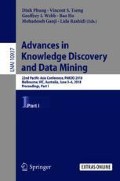Abstract
This paper presents a generic anomaly detection approach for time-series data. Existing anomaly detection approaches have several drawbacks such as a large number of false positives, parameters tuning difficulties, the need for a labeled dataset for training, use-case restrictions, or difficulty of use. We propose DeepAD, an anomaly detection framework that leverages a plethora of time-series forecasting models in order to detect anomalies more accurately, irrespective of the underlying complex patterns to be learnt. Our solution does not rely on the labels of the anomalous class for training the model, nor for optimizing the threshold based on highest detection given the labels in the training data. We compare our framework against EGADS framework on real and synthetic data with varying time-series characteristics. Results show significant improvements on average of 25% and up to \(40-50\)% in \(F_1{\text{- }}score\), precision, and recall on the Yahoo Webscope Benchmark.
This project has received funding from the European Union’s Horizon 2020 research and innovation programme under the Grant Agreement No. 700381 (ASGARD) and No. 671625 (CogNet).
Access this chapter
Tax calculation will be finalised at checkout
Purchases are for personal use only
Notes
- 1.
- 2.
- 3.
Yahoo! Webscope dataset ydata-labeled-time-series-anomalies-v1_0. http://webscope.sandbox.yahoo.com.
References
Aggarwal, C.C.: An introduction to outlier analysis. In: Outlier analysis, pp. 1–40. Springer, New York (2013)
Al-Jarrah, O., Arafat, A.: Network intrusion detection system using neural network classification of attack behavior. J. Adv. Inf. Technol. 6(1) (2015)
Amer, M., Goldstein, M., Abdennadher, S.: Enhancing one-class support vector machines for unsupervised anomaly detection. In: ACM SIGKDD, pp. 8–15 (2013)
Buda, T.S., Assem, H., Xu, L.: Ade: an ensemble approach for early anomaly detection. In: IFIP/IEEE IM, pp. 442–448 (2017)
Chandola, V., Banerjee, A., Kumar, V.: Anomaly detection: a survey. ACM Comput. Surv. (CSUR) 41(3), 15 (2009)
Chauhan, S., Vig, L.: Anomaly detection in ECG time signals via deep long short-term memory networks. In: IEEE DSAA, pp. 1–7 (2015)
Dixon, W.J., Massey Frank, J.: Introduction to Statistical Analsis. McGraw-Hill Book Company Inc., New York (1950)
Dunlop, N.: Statistical Calculations, pp. 203–224. Apress, Berkeley (2015)
Görnitz, N., Kloft, M.M., Rieck, K., Brefeld, U.: Toward supervised anomaly detection. J. Artif. Intell. Res. 46, 235–262 (2013)
Hawkins, D.M.: Identification of outliers, vol. 11. Springer, Netherlands (1980)
Laptev, N., Amizadeh, S., Flint, I.: Generic and scalable framework for automated time-series anomaly detection. In: ACM SIGKDD, pp. 1939–1947 (2015)
Malhotra, P., Ramakrishnan, A., Anand, G., Vig, L., Agarwal, P., Shroff, G.: LSTM-based encoder-decoder for multi-sensor anomaly detection (2016). arXiv preprint arXiv:1607.00148
Malhotra, P., Vig, L., Shroff, G., Agarwal, P.: Long short term memory networks for anomaly detection in time series. In: ESANN (2015)
Noto, K., Brodley, C., Slonim, D.: Frac: a feature-modeling approach for semi-supervised and unsupervised anomaly detection. Data Min. Knowl. Discov. 25(1), 109–133 (2012)
Rajasegarar, S., Leckie, C., Palaniswami, M.: Hyperspherical cluster based distributed anomaly detection in wireless sensor networks. J. Parallel Distrib. Comput. 74(1), 1833–1847 (2014)
Author information
Authors and Affiliations
Corresponding author
Editor information
Editors and Affiliations
Rights and permissions
Copyright information
© 2018 Springer International Publishing AG, part of Springer Nature
About this paper
Cite this paper
Buda, T.S., Caglayan, B., Assem, H. (2018). DeepAD: A Generic Framework Based on Deep Learning for Time Series Anomaly Detection. In: Phung, D., Tseng, V., Webb, G., Ho, B., Ganji, M., Rashidi, L. (eds) Advances in Knowledge Discovery and Data Mining. PAKDD 2018. Lecture Notes in Computer Science(), vol 10937. Springer, Cham. https://doi.org/10.1007/978-3-319-93034-3_46
Download citation
DOI: https://doi.org/10.1007/978-3-319-93034-3_46
Published:
Publisher Name: Springer, Cham
Print ISBN: 978-3-319-93033-6
Online ISBN: 978-3-319-93034-3
eBook Packages: Computer ScienceComputer Science (R0)

